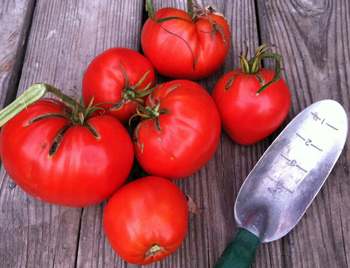Sauce tomatoes versus slicing tomatoes: does the difference matter?

Janice Leach | Contributor
One way of categorizing home-grown tomatoes is dividing them into tomatoes for cooking and making sauce and tomatoes for slicing and eating fresh. Are the categories really that different? I think the answer is both yes and no.
For slicing and eating fresh, many people recommend Brandywine, Mortgage Lifter, Cherokee Purple, Black Krim or Beefsteak tomatoes. These are among our favorites for BLTs, simple tomato salads or slicing and eating with a bit of salt and herbs.
For the most part, slicing tomatoes are roundish in shape and large, although sizes may vary. These tomatoes are generally quite juicy.
When we make sauce, we like to use Amish paste, San Marzano or Roma tomatoes. Sauce or paste tomatoes tend to be more oval, or oblong, or pear-shaped. They are also considered to be “dryer” having less liquid and more pulp than slicing tomatoes.
Although I tend to use tomatoes along these categories, I’m not hard-edged about it. Some cooks swear by a certain tomato for a particular use, but I like to mix varieties for a more complex taste, whether in making tomato sauce — or apple sauce or pie, for that matter.
Overall, I would argue that home-grown tomatoes are pretty interchangeable (grocery store tomatoes, for the most part, are only worth eating in desperation in January no matter how they are prepared.) Sauce tomatoes will do for a salad or BLT in my book, and big juicy slicing tomatoes also make good sauce, although they will take significantly longer to cook down.
When preparing sauce using tomatoes that have a lot of juice or seeds, you can speed up the cooking process by seeding the tomatoes before cooking. The easiest way I’ve found to do this is the cut the tomato in half along on the equator, as it were, and then gently squeeze with one hand while gently prodding the tomato cavities with a finger. I don’t obsess over seed removal because I run tomato sauce through the food mill after cooking to make a smooth sauce.
The tomatoes are still ripening in our garden, so I’m looking forward to more meals of fresh and cooked homegrown tomatoes. We planted some new-to-us varieties this year, and I was a little uncertain about which was which. The fun and informative Ann Arbor Farmers’ Market blog contained a link to a guide to tomato varieties on Rutgers New Jersey Agricultural Experiment Station, so I have been able to identify the varieties we planted that I’ve been unsure about.
Our home-made tomato sauce has the potential of including about a dozen varieties of tomatoes. I’m not a purist, however, I know our tomato sauce will be red, delicious — and plentiful, I hope.
How selective are you about the ways you use slicing or sauce tomatoes?
Jim and Janice Leach tend a backyard plot in downtown Ann Arbor, where they try to grow as many vegetables and other plants as possible. For the last five years, they've published gardening tips, photos and stories at their 20 Minute Garden website.


Comments
Sarah Rigg
Fri, Sep 14, 2012 : 12:48 p.m.
I loved cooked tomatoes but have never been able to abide raw (unless it's well-hidden in a sandwich) so every tomato variety gets cooked by me, even cherry and grape tomatoes. those little ones are actually pretty fantastic roasted whole or halved and pan-seared.
Jim and Janice Leach
Tue, Sep 25, 2012 : 1:02 p.m.
I do like tomatoes prepared just about any way, so some of our cherry tomatoes end up in salads. My experience of growing cherry tomatoes is that we always have many many more than we can eat fresh. The "extra" cherry tomatoes end up in tomato sauce, and I think they add a lot of sweetness so they are worth all the picking and gathering! There's no reason why they can't be used in place of other tomatoes in recipes.